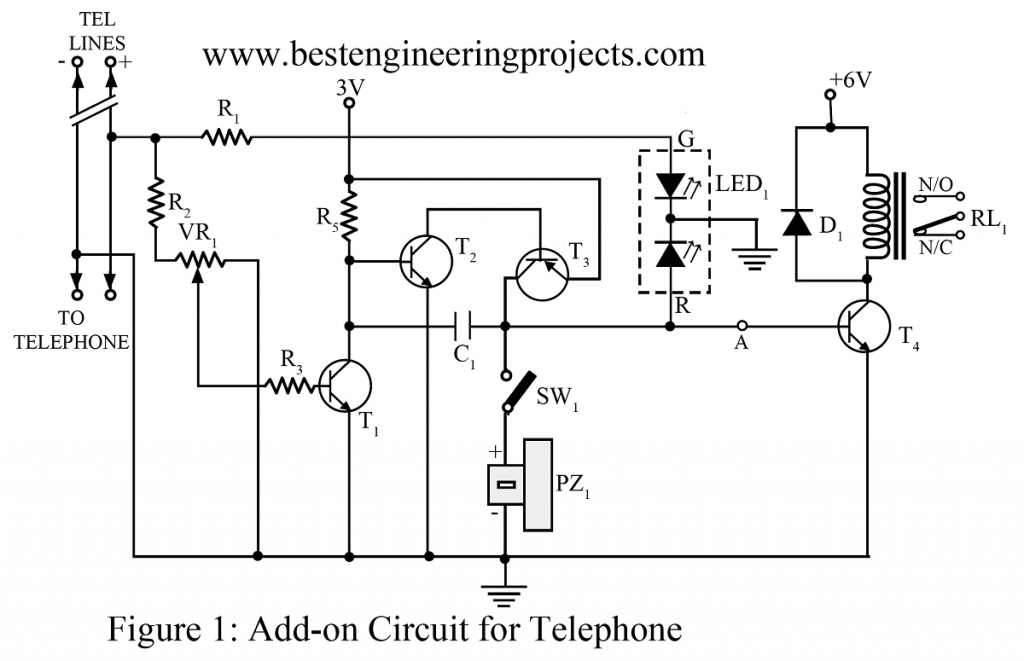This electronic project, Add on Device For Telephone has multiple applications when used with the telephone lines. Since it is added parallel on the telephone system, it is called add-on device. The circuit add on device for telephone supports three modes of operation: on-hook, off hook, and ringing modes. It also provides the audio-visual indication of these operations. Using the relay, add on device circuit can connect the telephone to a CID (caller identification device). It can also be used to indicate tapping or misuse of telephone lines with the aid of sound producing devices like a buzzer. The different modes supported by the add on device circuit for telephones are briefly described below.
Check out other phone/telephone related circuit posted in bestengineeringprojects.com
- Cell Phone Jammer Circuit
- Telephone Amplifier Circuit
- Phone Broadcaster Circuit
- Telephone Converter Circuit
- Telephone Spy
Circuit Description of Add on Device for Telephone
In on-hook mode, add on device must to maintain a 48v DC supply across the telephone lines. Here, the bi-color LED is used, which glows in green when the telephone is in ideal state. To adjust the glow of LED, a resistor R1 is used and its value is changed as per required so that the overall telephone system is not loaded and telephone performance remains undisturbed.
For off hook mode of the handset, a potentiometer VR1 is used. It is so adjusted that base of T1 (BC547) as shown in the figure is forward biased. As a result, it cuts off transistor T2 (BC108). During this whole process of adjusting potentiometer, it should be noted that the LED glows only in green signaling the telephone is in idle state, it should not go red.
As we lift the handset of telephone, the voltage across the system drops to 12V DC. This cause the transistor T1 to cutoff as the voltage across its base emitter junction falls below its conduction level. As a result, transistor pair starts oscillating and with the switch S1 in on mode, the piezo buzzer starts beeping. And, the LED glows red.
During the ringing mode of telephone system, the bi-color LED produces green flashes in synchronization with the telephone ring.
As mentioned earlier, the CID can be connected with the telephone using a relay. Using point A shown in the figure, the relay driver transistor can be added on the overall add on device for telephone circuit. Since the piezo buzzer gets activated with switch, switch S1 can be left in on position to add extra security to this whole process when anyone tries to tap the telephone line. Tapping of telephone line is similar to the off hook mode of the telephone handset.
For vcc1 power supply, two 1.5v pencil cells are used. But, for, a separate power supply is recommended to avoid excessive draining of the battery used. In spite of this methods, a single -volt power supply can be used in conjunction with a 3v zener diode to provide required voltages for both vcc1 and vcc2 supplies.
PARTS LIST OF ADD ON CIRCUIT FOR TELEPHONE
| Resistor (all ¼-watt, ± 5% Carbon) |
| R1 = 56 KΩ
R2 = 150 KΩ R3 = 1 KΩ R4 = 22 KΩ |
| Capacitor |
| C1 = 100 KpF (Ceramic Disc) |
| Semiconductors |
| T1 = BC547 (General Purpose NPN silicon transistor)
T2 = BC108 (General Purpose NPN silicon transistor) T3 = BC177 (General Purpose PNP silicon transistor) T4 = BC548 (General Purpose NPN silicon transistor) D1 = 1N4007 (Rectifier Diode) LED1 = Dual LED |
| Miscellaneous |
|
RL1 = 6V, 100Ω, SPDT Relay SW1 = ON/OFF switch PZ1 = Piezo Buzzer |
